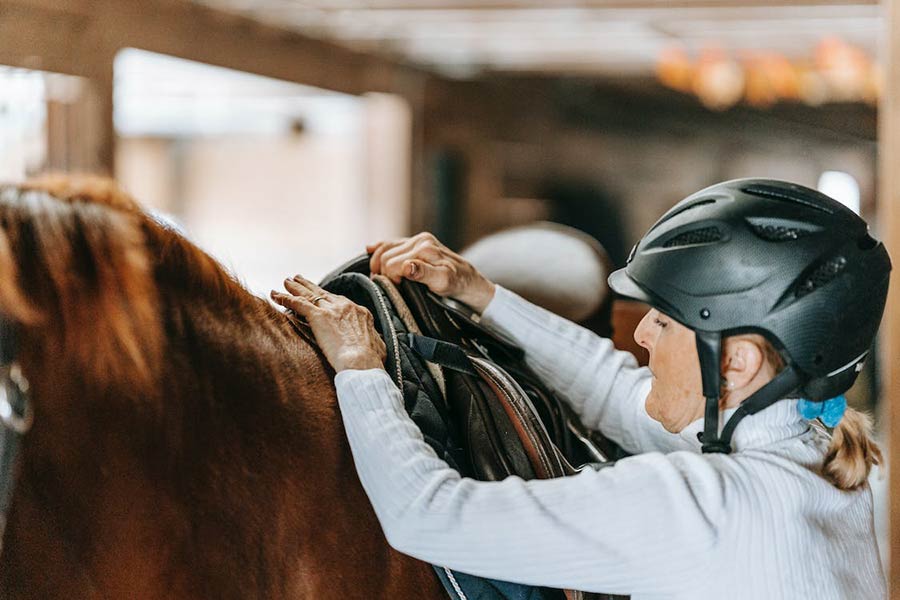
Over the past two years, the Virginia Tech Helmet Lab has analyzed over 100 videos of riders falling off horses. Precisely measured the hardness of the sand, dirt, grass, and synthetic surfaces underfoot at equestrian events. Dragged dummy heads and necks and pendulums and other equipment — and boxes and boxes of helmets — out to Virginia Tech’s equestrian facilities to simulate falls.
Then the team of researchers from the Department of Biomedical Engineering & Mechanics took all that data back to the lab to recreate those events in a series of controlled, quantitative tests. They used those tests to assess and rate 40 equestrian helmets from different manufacturers from one to five stars.
Equestrian sports account for 50,000 trips to the emergency room for concussions and other brain injuries, more than any other sport in America.
“When you think about the height of a horse and the distance a rider would fall, that translates into a high impact energy,” Stefan Duma, the Harry Wyatt Professor of Engineering and the Helmet Lab’s founder, said.
Of the 40 models tested, two earned the top score of five stars. Eleven earned four, and the rest earned three or below. Price isn’t necessarily a predictor of quality: One of the two five-star helmets retails for $460, and the other for $58.
The ratings apply to falls that occur during walking, trotting, galloping, jumping, and the wide variety of other horse movements that can occur in equestrian disciplines including hunter-jumper, eventing, and dressage.
The lab’s extensive testing also studied what happens during real impacts in the equestrian arena and illuminated gaps between the tests helmets have to pass before going on the market and the real world impacts when worn.
“Standards for equestrian helmets are typically based on severe impacts,” Duma said. “What we found is that a lot of riders come off at lower velocities, and many helmets are too stiff to effectively cushion those softer impacts. The helmets that perform better are able to deal with different energy levels.”
Virginia Tech’s ratings also go beyond the existing standards by using a formula that considers the rotational acceleration that occurs when a rider’s head hits the ground, in addition to linear acceleration.
This is the lab’s ninth major ratings release since researchers began rating helmets for a variety of sports in 2011.
“Every sport is different,” Duma said. “For these ratings, we determined what the acceleration profile would look like for a rider falling on the ground. Then we take that trace and bring it into the lab and recreate it, to make sure that our testing matches what a rider would experience if they fell off a horse.”
The team uses a pendulum impactor which strikes a head form protected by a helmet, and sensors inside the head form record the blow. Each helmet model was tested at three impact locations and two impact speeds that are representative of real-world falls.
Swedes Suggest More Testing Needed
The Swedish firm Mips (which stands for Multi-directional Impact Protection System) specializes in helmet-based safety and works with more than 150 helmet manufacturers worldwide. In a press release the company suggested that the Virginia Tech study was incomplete because it focused on falls where the rider falls directly to the ground.
In their experience, rotation is principally induced due to the head rotating around the neck, not at the first contact with the impacting surface. If a rider is moving forward when the fall occurs, there will be both vertical and horizontal velocity relative to the ground, and rotation could also be induced at the initial contact with the ground due to tangential force. To be able to replicate this phenomenon another test method is required, the release says.
“This could explain the discrepancy between Virginia Tech Helmet Lab’s ratings, and those from Swedish insurance company Folksam,” said Mips Co-Founder and Chief Science Officer Peter Halldin. “For example, a helmet rated 1-star by Virginia Tech is rated 5-star by Folksam. The Folksam rating program includes impacts that have a tangential force acting on the helmet, which we suggest Virginia Tech implements to complement their current test method.
“Additionally, the Virginia Tech rating system weights the front impact location and the lower impact velocity of 4.0 meter per second (m/s) higher than the impact velocity of 6.3 m/s. Therefore, the final rating of the helmets in the Virginia Tech rating program is more dependent on the performance of the front of the helmet and low velocity impacts. While we appreciate the new initiatives to evaluate equestrian helmets and promote helmet safety more generally, we at Mips believe that the new rating systems may be cause for confusion.”
To see the Virginia Tech helmet ratings visit helmet.beam.vt.edu. To learn more about the Mips ratings visit mipsprotection.com/equestrian.




